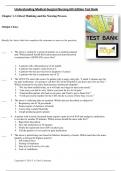Exam (elaborations)
Understanding Medical-Surgical Nursing 6th Edition Test Bank by Linda S. Williams, Paula D. Hoppe
- Course
- Institution
- Book
The document is not the original book; it's a handy collection of pre-written exam questions and answers that helps educators gauge students' understanding of the course material. It’s a great resource for creating quizzes and exams, saving teachers time and ensuring students are assessed f...
[Show more]




